vBCms Comments
Welcome To Hunting Country
General Hunting Forums
Archery & Bowhunting
Shooting Sports
Manufacturers' Corner
Firearms
Classifieds
Not Hunting / General Chit Chat
1.) bluecat - 03/21/2016
[B]Warning, this thread may contain archery content and possible peanut dust and/or nut biproducts as the poster is posting in an area where peanuts and/or nut products are consumed regularly.
[/B]
I told myself that the next time I was to cut some shafts I would try to get to the bottom of the whole spine issue thing. Does the bathtub technique hold water? (See what I did there?) I wanted to give my uncut arrow shafts a soaking in the tub and see if gravity does rotate the shaft. Presumably, the whole reason for doing this is to detect the heavy side of the arrow. Once that is determined, one assumes that the heavy side is the stiffest part of the arrow shaft. If that is known then all of the arrows will be indexed the same so they are all leaving the arrow rest with the stiffest part of the spine in the same location. The purpose of this is to provide for better downrange accuracy and truer paper tuning tests.
So here we go.
I took the uncut shafts and floated them in the bathtub in about 6 inches of water. I put a nock on each end to insure they would be airtight and float and also oriented them at 90 degrees to each other so there wouldn't be a nock effect that would give an advantage of weight. At first I couldn't see any rotation at all no matter how I spun or positioned the shaft in the water. Then I remembered that you need to add some soap to the water to break the surface tension and make the water a little more slippery. So I added some body wash to the water and agitated it. Now the shafts slowly turned to a particular orientation in the water indicating the heavy side of the shaft. The results were repeatable for a shaft - each time a shaft was rotated it rotated back to the same side as before. I marked the heavy side of the shaft with a marker. Note, make sure you move bubbles away from shaft as the bubbles will affect the arrow shaft's ability to rotate.
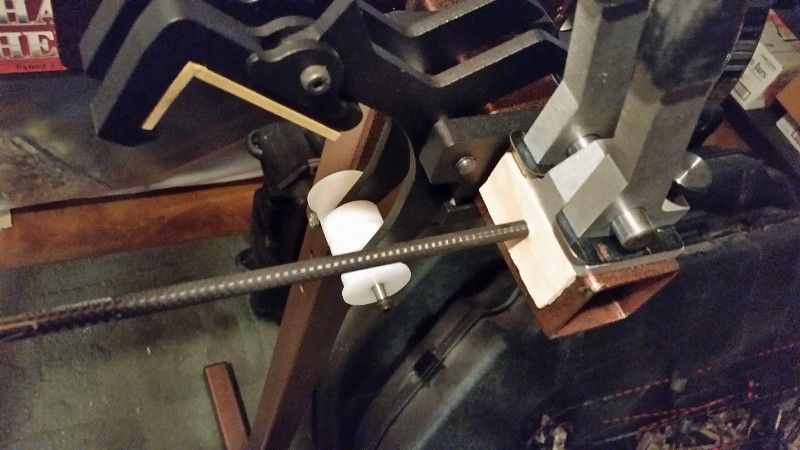
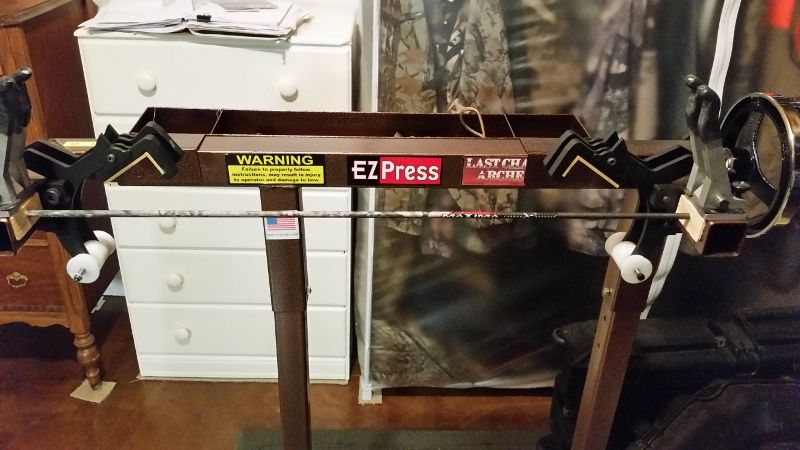
So now that that was done, I wanted to put the shafts in my bow press and slowly press the arrow to see if the marked side (heaviest) of the shaft corresponds to the stiffest side. So I put an unglued insert into each side of the shaft and positioned the shaft equally in the press and slowly pressed against a small block of wood.
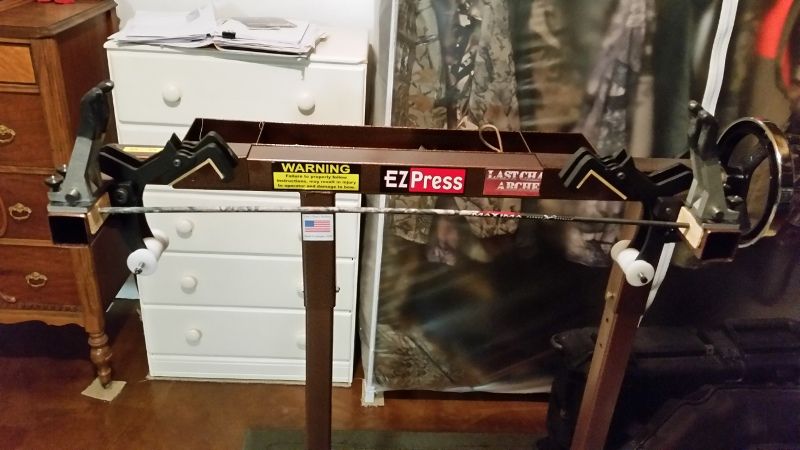
The arrow bowed but only bowed in one direction no matter how I rotated the shaft. Strange.
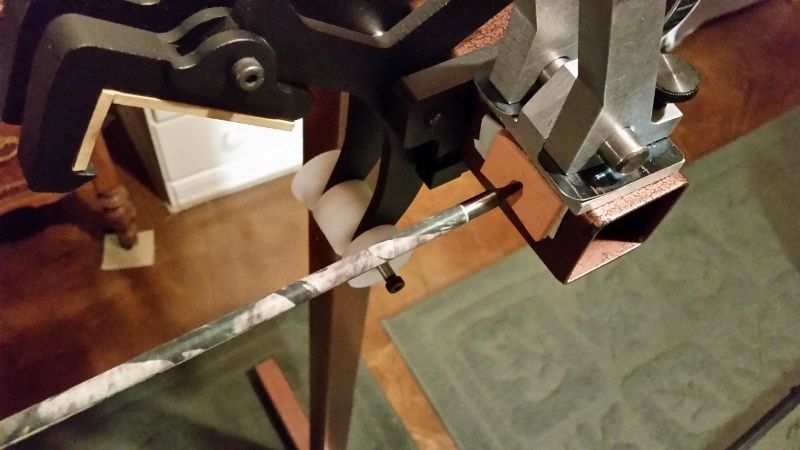
After playing with this for awhile I then decided to put a field point on both ends of the shaft so the shaft meets the press at a very small point and eliminates any other effects. I put a small piece of leather between field point and press to protect the finish on my press.
Now when I pressed the arrow, the arrow flexed differently. If the arrow flexed downward, I relaxed the press, rotated the shaft 90 degress and pressed again, the arrow now flexed 90 degrees to the original pressing as expected. Great. The goofy part of all this was, I could get the arrow to flex two ways but never 180 degrees from each other. In other words, if the arrow flexed down, I could never get it to flex up regardless of how it was oriented in the press.
I should mention that I'm using Carbon Express Maxima Hunter 250's. They supposedly are dual spine. Is that what is causing this?
After playing with this for a length of time, I finally gave up and just glued in my inserts like I always do.
Note, there was no obvious correlation between the bathtub test and the way the shaft was flexing in the press. I'm assuming that the bathtub test was concocted as a way to test spine without need of further tools or testing.
I've done my due diligence on this matter. I'm welcome to all sorts of feedback, criticism, jeering, pictures of women's boobs etc.
[/B]
I told myself that the next time I was to cut some shafts I would try to get to the bottom of the whole spine issue thing. Does the bathtub technique hold water? (See what I did there?) I wanted to give my uncut arrow shafts a soaking in the tub and see if gravity does rotate the shaft. Presumably, the whole reason for doing this is to detect the heavy side of the arrow. Once that is determined, one assumes that the heavy side is the stiffest part of the arrow shaft. If that is known then all of the arrows will be indexed the same so they are all leaving the arrow rest with the stiffest part of the spine in the same location. The purpose of this is to provide for better downrange accuracy and truer paper tuning tests.
So here we go.
I took the uncut shafts and floated them in the bathtub in about 6 inches of water. I put a nock on each end to insure they would be airtight and float and also oriented them at 90 degrees to each other so there wouldn't be a nock effect that would give an advantage of weight. At first I couldn't see any rotation at all no matter how I spun or positioned the shaft in the water. Then I remembered that you need to add some soap to the water to break the surface tension and make the water a little more slippery. So I added some body wash to the water and agitated it. Now the shafts slowly turned to a particular orientation in the water indicating the heavy side of the shaft. The results were repeatable for a shaft - each time a shaft was rotated it rotated back to the same side as before. I marked the heavy side of the shaft with a marker. Note, make sure you move bubbles away from shaft as the bubbles will affect the arrow shaft's ability to rotate.


So now that that was done, I wanted to put the shafts in my bow press and slowly press the arrow to see if the marked side (heaviest) of the shaft corresponds to the stiffest side. So I put an unglued insert into each side of the shaft and positioned the shaft equally in the press and slowly pressed against a small block of wood.

The arrow bowed but only bowed in one direction no matter how I rotated the shaft. Strange.

After playing with this for awhile I then decided to put a field point on both ends of the shaft so the shaft meets the press at a very small point and eliminates any other effects. I put a small piece of leather between field point and press to protect the finish on my press.
Now when I pressed the arrow, the arrow flexed differently. If the arrow flexed downward, I relaxed the press, rotated the shaft 90 degress and pressed again, the arrow now flexed 90 degrees to the original pressing as expected. Great. The goofy part of all this was, I could get the arrow to flex two ways but never 180 degrees from each other. In other words, if the arrow flexed down, I could never get it to flex up regardless of how it was oriented in the press.
I should mention that I'm using Carbon Express Maxima Hunter 250's. They supposedly are dual spine. Is that what is causing this?
After playing with this for a length of time, I finally gave up and just glued in my inserts like I always do.
Note, there was no obvious correlation between the bathtub test and the way the shaft was flexing in the press. I'm assuming that the bathtub test was concocted as a way to test spine without need of further tools or testing.
I've done my due diligence on this matter. I'm welcome to all sorts of feedback, criticism, jeering, pictures of women's boobs etc.
2.) DParker - 03/21/2016
Nice write-up and set of accompanying photos to illustrate the process. However, I fail to see what it has to do with Donald Trump.
3.) bluecat - 03/21/2016
Well, after I completed my testing all Hell broke loose with shouting, pushing, shoving and name calling. Then I vowed to make my arrows fly great again with no clear plan or strategy on how to actually do it.
...and I would make the Pro shop pay for my time.
...and I would make the Pro shop pay for my time.
4.) bluecat - 03/21/2016
You know it might be I just never found the positioning point at which pressure from the press pressed both sides of the shaft equally so I was always biasing my results. But then again, if this is something that is that prone to error, it really isn't useful to 99% of people.
5.) bluecat - 03/21/2016
Now that I'm thinking more about this, maybe I should have put a bubble level on the shaft.
6.) bluecat - 03/21/2016
The arrow should be square in the press from two different axes.
7.) Jon - 03/22/2016
I would throw out the bow press test and just mark the "heavy" side of the arrow and orient all the vanes the same on those arrows so it's easier to paper tune. That's really all you need to know.
8.) bluecat - 03/22/2016
Not sure the "heavy" side of the arrow would influence paper tuning Jon. The "heavy" side of the arrow is not necessarily where the shaft wants to naturally flex based on spine. At least that is what I'm experiencing and reading.
9.) bluecat - 03/22/2016
Here's a couple of chuckle heads doing the same thing. Also look at the comments ([url]https://www.youtube.com/watch?v=lH3CdQtiCv0[/url]). One comment states they can't get the arrow to bend up, it always bends down. I experienced the same thing. Don't know how the commenter is pressing the arrow but it makes you wonder if these results are not so accurate and it is extremely important the position the arrow is compressed in the press.
If there was truly a weak side of the spine, then I see no reason why the arrow wouldn't bend up if in the proper position.
10.) bluecat - 03/22/2016
Your best bet might be to bare shaft test (shooting them through paper and rotating the nock).
I'm not sure I would have the shoulder strength to do a dozen arrows. It would take many many shots for me to discern a spine rotation problem as opposed to operator error.
I'm not sure I would have the shoulder strength to do a dozen arrows. It would take many many shots for me to discern a spine rotation problem as opposed to operator error.
11.) Jon - 03/22/2016
What I'm saying is, if you reference the "heavy" side the same on every arrow when you fletch (ie. orient the fletch in relation to where you marked the heavy side) then the arrows should all fly the same. Same goes with the nock but that should be obvious since the nock is always the same orientation with the fletching.
Are you smelling what I'm layin?
Are you smelling what I'm layin?
12.) bluecat - 03/22/2016
I'm smelling something. :wink
I think we are in disagreement about what happens when you "loose" the arrow. The arrow is going to respond based on the spine flex regardless of whether it happens to be the heavy or light side. If I float all the shafts and mark them and fletch all the shafts so the heavy side is the same direction (not sure it matters which side), the arrow is still going to flex based on the spine. So heavy, light is of no consequence. One shaft may flex to the right with heavy side down, the next shaft may flex up with the heavy side down.
The whole bathwater thing, in my understanding, was making the assumption that heavy/light corresponded to spine flex, which isn't true.
I think we are in disagreement about what happens when you "loose" the arrow. The arrow is going to respond based on the spine flex regardless of whether it happens to be the heavy or light side. If I float all the shafts and mark them and fletch all the shafts so the heavy side is the same direction (not sure it matters which side), the arrow is still going to flex based on the spine. So heavy, light is of no consequence. One shaft may flex to the right with heavy side down, the next shaft may flex up with the heavy side down.
The whole bathwater thing, in my understanding, was making the assumption that heavy/light corresponded to spine flex, which isn't true.
13.) bluecat - 03/22/2016
Watching that video multiple times, I think I should have manipulated the arrow in the press under compression and see how the arrow responded. They said the flex side is the weak side and the spine is 90 degrees to that.
They also stated it made no difference how you orient your vanes with regard to the stiff side. The key is that you fletch them all the same. Now all the arrows should flex the same initially when released which is the whole goal.
They also stated it made no difference how you orient your vanes with regard to the stiff side. The key is that you fletch them all the same. Now all the arrows should flex the same initially when released which is the whole goal.
14.) bluecat - 03/22/2016
They also mentioned that the shaft needs to be flexed a little more rapidly than what I was doing which was a "kinder and gentler" approach.
15.) bluecat - 03/22/2016
I will put some of that knowledge to acid test soon and see if I can come out of this a little wiser. Still have half a dozen arrow shafts.
16.) Jon - 03/22/2016
Pretty sure you aren't smelling what I'm laying down but press on with more testing.:bang:
17.) bluecat - 03/22/2016
Why would you want to index your nocks to something that doesn't affect arrow flight? What's the point?
18.) Jon - 03/23/2016
Test everything you can and after doing it for about 15 years, get back to me with what you've learned. EVERYTHING matters and if you have a starting point that you can index against and everything is consistent, you'll have good arrow flight. Why do people have such a hard time taking advice?
19.) bluecat - 03/23/2016
Actually, I take advice quite well and constantly revise. I agree that if you have a starting point that you can index against and everything is consistent you'll have (not necessarily good but) consistent arrow flight. What we are disagreeing about is the fact that I don't believe the heavy side of the shaft correlates to the spine of the arrow. My test showed that and others as well. I believe based on what I've read that the spine's plane of weakness/strength determines how the spine flexes when compressed due to string pushing on nock, which is why you are seeing more people testing their shafts using compression than floating them in a bathtub (which I might add, I thought was pretty ingenious at the time). I would rather invest my energy into determining the arrow shaft's plane of weakness/strength [B]and index to this [/B]rather than put my shafts in a bathtub to find out which side weighs a few more grains. You would have to agree that if one shaft flexes right coming off the rest and the next shaft flexes left coming off the rest that they would not obtain optimum consistency.
If it's just a consistency thing and not based on science then why not index your nocks to the Carbon Express Logo?
I'm more than willing to say that I'm wrong. I posted this to help others and to get feedback. I don't care if someone can show me where I'm wrong. I encourage it. It's called the iterative process. I'm not trying to be belligerent, I'm trying to understand. It just has to make sense to me before I can adopt it. I have a tendency to want to understand the meat and potatoes of things and not just say, "because that is what you do".
I'm glad you are on the forum. You know a lot. I look up to you. I wish you posted more.
If it's just a consistency thing and not based on science then why not index your nocks to the Carbon Express Logo?
I'm more than willing to say that I'm wrong. I posted this to help others and to get feedback. I don't care if someone can show me where I'm wrong. I encourage it. It's called the iterative process. I'm not trying to be belligerent, I'm trying to understand. It just has to make sense to me before I can adopt it. I have a tendency to want to understand the meat and potatoes of things and not just say, "because that is what you do".
I'm glad you are on the forum. You know a lot. I look up to you. I wish you posted more.
20.) bluecat - 03/23/2016
Actually, I take advice quite well and constantly revise. I agree that if you have a starting point that you can index against and everything is consistent you'll have (not necessarily good but) consistent arrow flight. What we are disagreeing about is the starting point. I don't believe the heavy side of the shaft correlates to the spine of the arrow. My test showed that and others as well. The spine's plane of weakness/strength determines how the spine flexes when compressed due to string pushing on nock, which is why you are seeing more people testing their shafts using compression than floating them in a bathtub (which I might add, I thought was pretty ingenious at the time). I would rather invest my energy into determining the arrow shaft's plane of weakness/strength [B]and index to this [/B]rather than put my shafts in a bathtub to find out which side weighs a few more grains. You would have to agree that if one shaft flexes right coming off the rest and the next shaft flexes left coming off the rest that they would not obtain optimum consistency.
If it's just a consistency thing and not based on science then why not index the nocks to the Carbon Express Logo?
I'm more than willing to say that I'm wrong. I posted this to help others and to get feedback. I don't care if someone can show me where I'm wrong. I encourage it. It's called the iterative process. I'm not trying to be belligerent, I'm trying to understand. It just has to make sense to me before I can adopt it. I have a tendency to want to understand the meat and potatoes of things and not just say, "because that is what you do".
I'm glad you are on the forum. You know a lot. I look up to you. I wish you posted more.
If it's just a consistency thing and not based on science then why not index the nocks to the Carbon Express Logo?
I'm more than willing to say that I'm wrong. I posted this to help others and to get feedback. I don't care if someone can show me where I'm wrong. I encourage it. It's called the iterative process. I'm not trying to be belligerent, I'm trying to understand. It just has to make sense to me before I can adopt it. I have a tendency to want to understand the meat and potatoes of things and not just say, "because that is what you do".
I'm glad you are on the forum. You know a lot. I look up to you. I wish you posted more.
21.) Jon - 03/23/2016
I don't post much because there are 4 guys on here who post daily, I have no input on Nascar, Texas food or cats so I really don't think I add much :grin:
Anyway, I don't want anyone to get so wrapped up in arrow spine flex that they lose sight of what's important. the important thing is consistency, this is true in your draw, your string construction, your release mechanism, and certainly your arrow reaction after being released from the string. Your mention of the Carbon Express logo is of note, some high end manufacturers used to put their logo on the heavy side (might have been the heavy side BECAUSE of the logo?) This gave a good index point.
Arrow flight leaving the bow has more to do with PROPER spine than deviation of that spine along the shaft of the arrow. Having proper spine goes much further than worrying about where the "heavy side" sits. I'll say that ensuring you are using the proper spine and the straightest arrow you can get along with being cut squarely from both ends and glued in properly will give better flight than floating the arrow and using that for whatever it is used for.
If you are very careful about your arrow construction, meaning being anal about every little process (cutting, squaring, gluing, fletching, using best inserts and nocks, ensuring the glue is evenly dispersed), you will get consistent arrow flight. Knowing how to properly tune your bow and your arrows will also go a long way.
Go on youtube and watch some of those high speed videos of arrows leaving a bow, I've never paid attention to the flex of the arrow after leaving the bow and if they always flex the same way time after time. I'll assume the flex is affected somewhat by the type of rest but I have no scientific backing on that claim.
Anyway, once you get to the point that you are fine tuning your arrow, you have reached the pinnacle of archery. Like a gun, most guns out perform their trigger fingers. I can't shoot as well as my bow can but when I was shooting competitively, I did my best to ensure everything was as perfect as I could get it. Now, I buy arrows and slap them together and go shooting!
Anyway, I don't want anyone to get so wrapped up in arrow spine flex that they lose sight of what's important. the important thing is consistency, this is true in your draw, your string construction, your release mechanism, and certainly your arrow reaction after being released from the string. Your mention of the Carbon Express logo is of note, some high end manufacturers used to put their logo on the heavy side (might have been the heavy side BECAUSE of the logo?) This gave a good index point.
Arrow flight leaving the bow has more to do with PROPER spine than deviation of that spine along the shaft of the arrow. Having proper spine goes much further than worrying about where the "heavy side" sits. I'll say that ensuring you are using the proper spine and the straightest arrow you can get along with being cut squarely from both ends and glued in properly will give better flight than floating the arrow and using that for whatever it is used for.
If you are very careful about your arrow construction, meaning being anal about every little process (cutting, squaring, gluing, fletching, using best inserts and nocks, ensuring the glue is evenly dispersed), you will get consistent arrow flight. Knowing how to properly tune your bow and your arrows will also go a long way.
Go on youtube and watch some of those high speed videos of arrows leaving a bow, I've never paid attention to the flex of the arrow after leaving the bow and if they always flex the same way time after time. I'll assume the flex is affected somewhat by the type of rest but I have no scientific backing on that claim.
Anyway, once you get to the point that you are fine tuning your arrow, you have reached the pinnacle of archery. Like a gun, most guns out perform their trigger fingers. I can't shoot as well as my bow can but when I was shooting competitively, I did my best to ensure everything was as perfect as I could get it. Now, I buy arrows and slap them together and go shooting!
22.) bluecat - 03/23/2016
Don't disagree with anything you just posted. I've reached the pinnacle of tuning because I'm such a crappy shooter...LOL!
Hey Jon, please jump in more with bow tech stuff. Hell, I'll send you a cat if that helps.
Hey Jon, please jump in more with bow tech stuff. Hell, I'll send you a cat if that helps.
23.) DParker - 03/23/2016
[QUOTE=Jon;40346]I don't post much because there are 4 guys on here who post daily....[/QUOTE]
So, just think...you could single-handedly boost site content by 25%!
Just stay stay in your lane when it comes to chili and you'll be OK. :grin:
So, just think...you could single-handedly boost site content by 25%!
Just stay stay in your lane when it comes to chili and you'll be OK. :grin:
24.) Jon - 03/23/2016
BEANS!!
25.) DParker - 03/23/2016
Damn yankees.
26.) Jon - 03/23/2016
:wink
27.) Triton Rich - 03/24/2016
[B]I don't disagree that there is something to be gained by floating or flexing arrows to find the heavy side or the more flexible side. However, the gain would be small enough that the vast majority of archers wouldn't notice. The tiniest break in form or the slightest error in tuning the bow or even gluing a fletch on very slightly crooked would all have a much greater impact. Yes, I believe every individual should put in the maximum effort they can to make everything consistent, I just think that effort should be first aimed at form, tuning, arrow construction etc. A guy who's paycheck depends on drilling a little tiny dot over and over again and who has perfect form already might feel different of course. :-)[/B]
28.) crookedeye - 03/25/2016
with jons mind on archery related subjects and my mind on political issues. this site should be total caious in a week or 2, making this site great again..:re:
29.) crookedeye - 03/25/2016
and bullzi ability to handle a sausage link from a sausage maker..we have everything it takes...lol
30.) bluecat - 03/25/2016
We depend on you CE for your in-depth political and social commentary. You can't put a price on that.
31.) Jon - 03/25/2016
Good thing I don't have a cat question
32.) DParker - 03/25/2016
[QUOTE=Jon;40407]Good thing I don't have a cat question[/QUOTE]
Even better if you don't have a cat.
[URL="http://www.cbsnews.com/news/cat-parasite-toxoplasa-gondii-linked-to-anger-aggression-rage/"]Common cat parasite linked to angry outbursts in humans[/URL]
Even better if you don't have a cat.
[URL="http://www.cbsnews.com/news/cat-parasite-toxoplasa-gondii-linked-to-anger-aggression-rage/"]Common cat parasite linked to angry outbursts in humans[/URL]
33.) Hunter - 03/26/2016
[QUOTE=Jon;40350]BEANS!![/QUOTE]
Beans for me too!
Just thought I would throw that in :wave:
Beans for me too!
Just thought I would throw that in :wave:
34.) bluecat - 04/27/2016
There is an on-going thread on this topic on the dark side I just found. It is over 50 pages with lots of anecdotal evidence. When I get the chance I'll try to read it all. Pretty interesting so far.
There are some knowledgeable people on the subject for sure. Some, not so much. I'll try and report back as I know many of you are really wrestling with this.
There are some knowledgeable people on the subject for sure. Some, not so much. I'll try and report back as I know many of you are really wrestling with this.
35.) bluecat - 04/28/2016
Found this post which sums up what I found out.
[I]Floating shafts is a leftover from traditional archery and wooden shafts, the best that can be said about the procedure is that it is inaccurate but at worst, it actually doesn't find the spine. Just because one side is heavier than the other side doesn't mean it is the spine.
Spine is: " the spine is the direction of greatest stiffness of the shaft"[/I]
GRIM
[url]http://www.crossbownation.com/community/threads/water-float-spine-test-vs-mechanical-spine-test.26527/[/url]
[I]Floating shafts is a leftover from traditional archery and wooden shafts, the best that can be said about the procedure is that it is inaccurate but at worst, it actually doesn't find the spine. Just because one side is heavier than the other side doesn't mean it is the spine.
Spine is: " the spine is the direction of greatest stiffness of the shaft"[/I]
GRIM
[url]http://www.crossbownation.com/community/threads/water-float-spine-test-vs-mechanical-spine-test.26527/[/url]
36.) bluecat - 03/08/2017
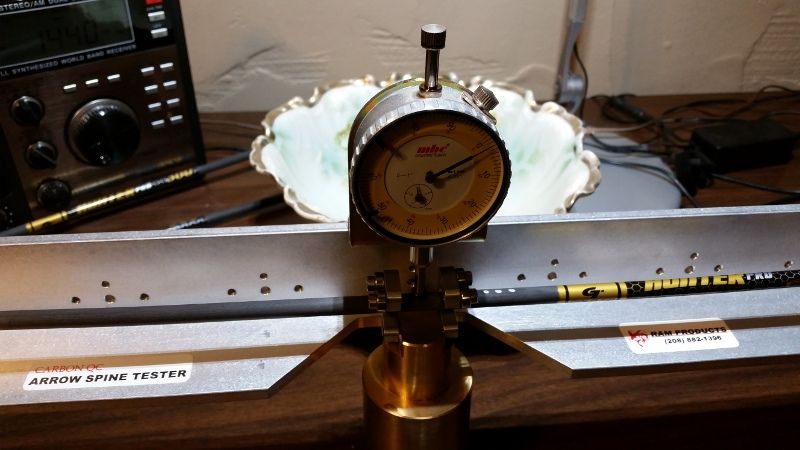
Purchased the RAM spine tester a few months back and when I got the next batch of arrows, verified the spine of each arrow easily. The three dots indicate the stiff side of the arrow. Haven't bareshaft tuned yet but that is coming in the next few weeks.
37.) Swamp Fox - 03/09/2017
[QUOTE=DParker;40408]Even better if you don't have a cat.
[URL="http://www.cbsnews.com/news/cat-parasite-toxoplasa-gondii-linked-to-anger-aggression-rage/"]Common cat parasite linked to angry outbursts in humans[/URL][/QUOTE]
I thought it was just Obama...
[URL="http://www.cbsnews.com/news/cat-parasite-toxoplasa-gondii-linked-to-anger-aggression-rage/"]Common cat parasite linked to angry outbursts in humans[/URL][/QUOTE]
I thought it was just Obama...
38.) Swamp Fox - 03/09/2017
Here's an entertaining read on building your own spine tester.I'll never do it, but as I said, it was an entertaining read...
:beer:
[url]http://poorfolkbows.com/spine1.htm[/url]
:beer:
[url]http://poorfolkbows.com/spine1.htm[/url]
39.) bluecat - 03/09/2017
Very creative. The concept is simple. If you are just measuring where the spine is located, the amount of weight isn't really a factor. You just want the arrow to bend while you rotate the arrow to locate stiff side.
40.) bluecat - 03/29/2017
So after fletching up a few of my arrows with respect to the spine, I set my nock at dead level and rest at 13/16ths from riser. Shot my Defiant. Had a nasty right tear. Two twists to the yoke and bullet hole. Walked back 15 yards and fired off both fletched and unfletched arrows.

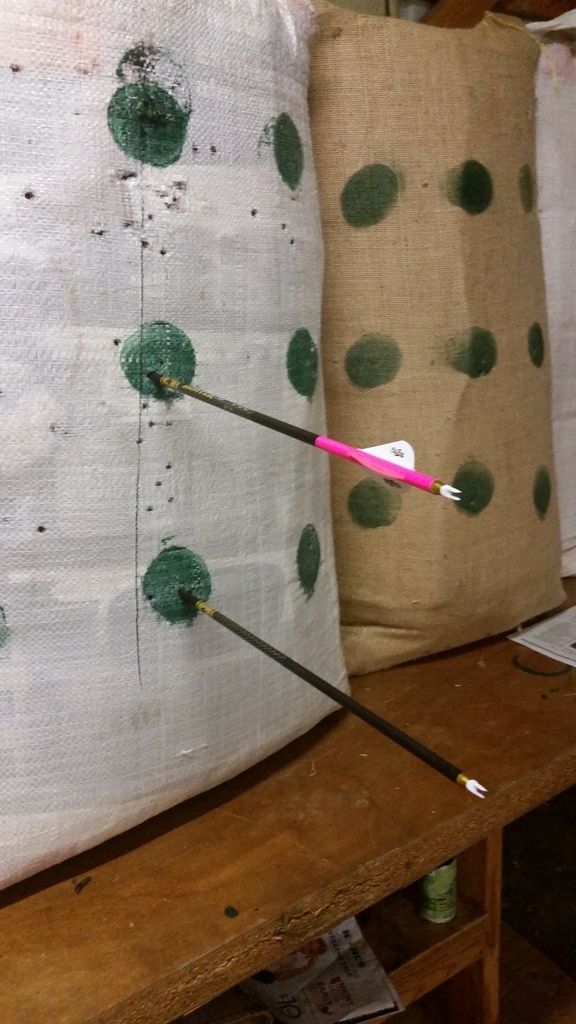
This was my Vector, nock set at dead level and rest at 13/16ths from riser. No adjustments were necessary.

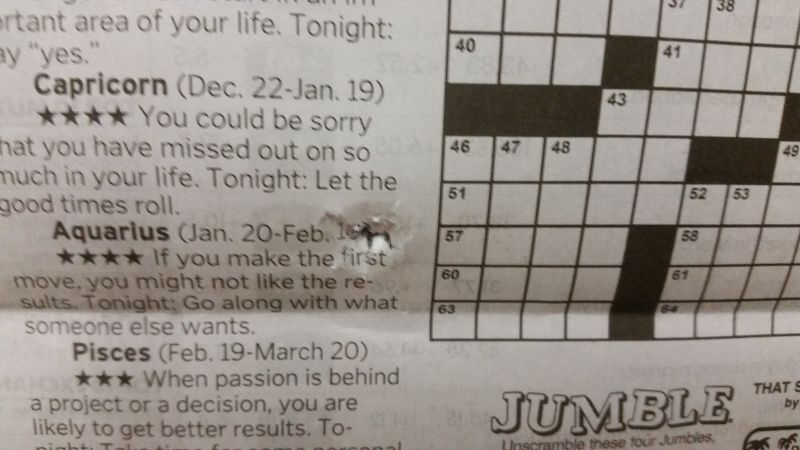
I can't attribute my tune to any one thing but knowing the spine definately helped.


This was my Vector, nock set at dead level and rest at 13/16ths from riser. No adjustments were necessary.


I can't attribute my tune to any one thing but knowing the spine definately helped.
41.) Swamp Fox - 03/29/2017
:tu:
I know there's a joke up there somewhere, but it's not coming to me yet...
I know there's a joke up there somewhere, but it's not coming to me yet...
42.) bluecat - 03/29/2017
"We wouldn't be so angry if Trump was doing something more positive."
43.) Swamp Fox - 03/29/2017
LOL....That's definitely one of them. :tu:
44.) bluecat - 03/29/2017
I knew that those spine tests would be beneficial to someone...
45.) Jon - 03/30/2017
So, reading back on this thread for a year do you now understand what I was saying about the stiff side of the spine and indexing your fletch with that on each arrow?
46.) bluecat - 03/30/2017
I've always understood that concept which is why I set about to find the stiff side of the shaft. My experiments took me to two methods which proved to be worthless - floating in water, putting arrows in press.
Where we differed was you said the heavy part of the shaft was the stiff side and that isn't always the case. Floating in water finds the heavy side which as I referenced in post #34 is not necessarily an indicator of the stiff side of the shaft. The RAM spine tester finds the stiff side of the shaft. The fact that the cams were timed perfectly, all arrows cut meticulously and squared, all arrows leaving the bow in the same orientation, arrows at .001 straightness, proper form and grip from a perfectly timed drop-away didn't hurt either. :)
Where we differed was you said the heavy part of the shaft was the stiff side and that isn't always the case. Floating in water finds the heavy side which as I referenced in post #34 is not necessarily an indicator of the stiff side of the shaft. The RAM spine tester finds the stiff side of the shaft. The fact that the cams were timed perfectly, all arrows cut meticulously and squared, all arrows leaving the bow in the same orientation, arrows at .001 straightness, proper form and grip from a perfectly timed drop-away didn't hurt either. :)
47.) Swamp Fox - 03/30/2017
I didn't read the comments for the video, but did anyone ever explain why the video demonstrates consistent flex performance in the press, and others can't duplicate it?
In an ideal world, the bow press test and the Ram spine tester should show the same results, correct?
In an ideal world, the bow press test and the Ram spine tester should show the same results, correct?
48.) bluecat - 03/30/2017
I guess maybe in a perfect world, yes Swampy. The problem is (in my testing) that if you flex an arrow and you are putting uneven pressure on the arrow in any plane you would be forcing the arrow to flex unnaturally.
The spine tester is as easy to use as falling off a log. Accurate and consistent 100% of the time.
The spine tester is as easy to use as falling off a log. Accurate and consistent 100% of the time.
49.) Swamp Fox - 03/30/2017
Even I can fall off a log!---LOL
50.) bluecat - 03/30/2017
[QUOTE=Swamp Fox;48051]I didn't read the comments for the video, but did anyone ever explain why the video demonstrates consistent flex performance in the press, and others can't duplicate it?
In an ideal world, the bow press test and the Ram spine tester should show the same results, correct?[/QUOTE]
Re-reading your post, I'm not sure that they were getting accurate results. Would like to compare their results with the spine tester. They moved pretty fast and there was really no accountability aside from saying "it works".
In an ideal world, the bow press test and the Ram spine tester should show the same results, correct?[/QUOTE]
Re-reading your post, I'm not sure that they were getting accurate results. Would like to compare their results with the spine tester. They moved pretty fast and there was really no accountability aside from saying "it works".
51.) Bob Peck - 03/30/2017
[QUOTE=Jon;40346]Now, I buy arrows and slap them together and go shooting![/QUOTE]
I find threads like this very interesting (honest) as it reminds me of my former relentless pursuit of absolute perfection. It is the nature of a committed archer to tinker. I'm still a committed archer but my tinkering is reduced to making sure everything is tuned properly and then leaving the rig and arrows alone.
I buy and spin test the ACC's or FMJ's that I use in batches and adjust them accordingly. There is always a small inventory of arrows ready to go but unless I break, bend or lose one, I use the arrow that went through the animal provided it passes scrutiny. I still enjoy reading and try to stay open minded but like Jon, these days I focus on getting the arrow in the kill zone and I'm O.K with that.
I had a flashback to an archery camp that used to be run by a hunting industry "celebrity". To demonstrate (@ 20 yards) that it's more about bow tune than arrow tune we "students" stepped to the line with our bows recently professionally tuned and shot the rattiest quiver of arrows I've ever seen. Missing fletches, no fletches, various lengths, heavy aluminum tree trunks, super lightweight carbon shafts, various spine specs, broadheads missing blades, etc. By and large at that distance while arrow flight was less than ideal, the impact points were generally in the kill zone. This isn't proof you shouldn't tune arrows properly and irresponsible if you're attempting to humanely kill an animal. Although there was no chrono to measure this I'm sure terminal velocity was all over the map but it did prove you could still kill an animal with less than perfection.
I find threads like this very interesting (honest) as it reminds me of my former relentless pursuit of absolute perfection. It is the nature of a committed archer to tinker. I'm still a committed archer but my tinkering is reduced to making sure everything is tuned properly and then leaving the rig and arrows alone.
I buy and spin test the ACC's or FMJ's that I use in batches and adjust them accordingly. There is always a small inventory of arrows ready to go but unless I break, bend or lose one, I use the arrow that went through the animal provided it passes scrutiny. I still enjoy reading and try to stay open minded but like Jon, these days I focus on getting the arrow in the kill zone and I'm O.K with that.
I had a flashback to an archery camp that used to be run by a hunting industry "celebrity". To demonstrate (@ 20 yards) that it's more about bow tune than arrow tune we "students" stepped to the line with our bows recently professionally tuned and shot the rattiest quiver of arrows I've ever seen. Missing fletches, no fletches, various lengths, heavy aluminum tree trunks, super lightweight carbon shafts, various spine specs, broadheads missing blades, etc. By and large at that distance while arrow flight was less than ideal, the impact points were generally in the kill zone. This isn't proof you shouldn't tune arrows properly and irresponsible if you're attempting to humanely kill an animal. Although there was no chrono to measure this I'm sure terminal velocity was all over the map but it did prove you could still kill an animal with less than perfection.
52.) Swamp Fox - 03/30/2017
I thought that at the beginning of the video they showed one arrow being positioned different ways and giving consistent results. Or maybe it was different arrows showing different flex directions. Maybe I need to look at it again, LOL. In any event, I didn't notice/don't remember anything untoward.
But you're right: a head-to-head would be helpful.
But you're right: a head-to-head would be helpful.
53.) bluecat - 03/30/2017
I understand what you are saying. I watched the video many times and only grasped the main concept of what they were doing but got lost on their explanations and details. Head to head like you said.
54.) Jon - 03/30/2017
Bluecat, my point although misunderstood like most of my ramblings was that finding the stiff side or weak side was the important part because it allows you to consistently fletch and assemble the shaft which makes a consistent arrow. I don't think I was focusing on the fact that an arrow will roll onto it's stiff side when put in water, I didn't even care if it was stiff or weak side, just that you could identify the same side of an arrow by doing it.
Bob, I actually did the same thing with a hodge podge pile of arrows, different sizes, weights, fletch configurations etc and documented the results at 20yds. Out of about 30 arrows, there were probably 4 or 5 that didn't land within a 3" circle. It could have been me that caused it. Very surprised but that's understandable at closer ranges. Move back to 30 and you'll get a completely different result.
Bob, I actually did the same thing with a hodge podge pile of arrows, different sizes, weights, fletch configurations etc and documented the results at 20yds. Out of about 30 arrows, there were probably 4 or 5 that didn't land within a 3" circle. It could have been me that caused it. Very surprised but that's understandable at closer ranges. Move back to 30 and you'll get a completely different result.
55.) bluecat - 03/30/2017
[QUOTE=Jon;48069]Bluecat, my point although misunderstood like most of my ramblings was that finding the stiff side or weak side was the important part because it allows you to consistently fletch and assemble the shaft which makes a consistent arrow. I don't think I was focusing on the fact that an arrow will roll onto it's stiff side when put in water, I didn't even care if it was stiff or weak side, just that you could identify the same side of an arrow by doing it.
[/QUOTE]
Ah, I think I hear you now. :-)
[/QUOTE]
Ah, I think I hear you now. :-)
56.) BULLZ-i - 03/30/2017
AND I THOUGHT I WAS THE ONLY NORWEGIAN HERE.
57.) Bob Peck - 03/31/2017
[QUOTE=Jon;48069]Bob, I actually did the same thing with a hodge podge pile of arrows, different sizes, weights, fletch configurations etc and documented the results at 20yds. Out of about 30 arrows, there were probably 4 or 5 that didn't land within a 3" circle. It could have been me that caused it. Very surprised but that's understandable at closer ranges.[/QUOTE]
Of course. Depending on the arrow, the bow, the set up and a bunch of other factors the arrow flight doesn't completely stabilize inside the standard issue 20 yard archery shot.
[QUOTE=Jon;48069]Move back to 30 and you'll get a completely different result.[/QUOTE]
We stepped back in 10 yard increments out to 50 (for those that were confident at that distance) and videotaped the accuracy radically decay. At 50 yards none of us (6) put it on the target let alone the bullseye.
Of course. Depending on the arrow, the bow, the set up and a bunch of other factors the arrow flight doesn't completely stabilize inside the standard issue 20 yard archery shot.
[QUOTE=Jon;48069]Move back to 30 and you'll get a completely different result.[/QUOTE]
We stepped back in 10 yard increments out to 50 (for those that were confident at that distance) and videotaped the accuracy radically decay. At 50 yards none of us (6) put it on the target let alone the bullseye.
58.) Swamp Fox - 03/31/2017
[QUOTE=Bob Peck;48102] Depending on the arrow, the bow, the set up and a bunch of other factors the arrow flight doesn't completely stabilize inside the standard issue 20 yard archery shot.
[/QUOTE]
Are you talking about any old arrow shot from any old bow, or are you talking about a semi-appropriate fletched arrow shot from a bow that is not completely screwed up?
If the latter, would you still say arrow flight is not "stabilized" within 20 yards?
If yes, how are you defining stabilization?
[/QUOTE]
Are you talking about any old arrow shot from any old bow, or are you talking about a semi-appropriate fletched arrow shot from a bow that is not completely screwed up?
If the latter, would you still say arrow flight is not "stabilized" within 20 yards?
If yes, how are you defining stabilization?
